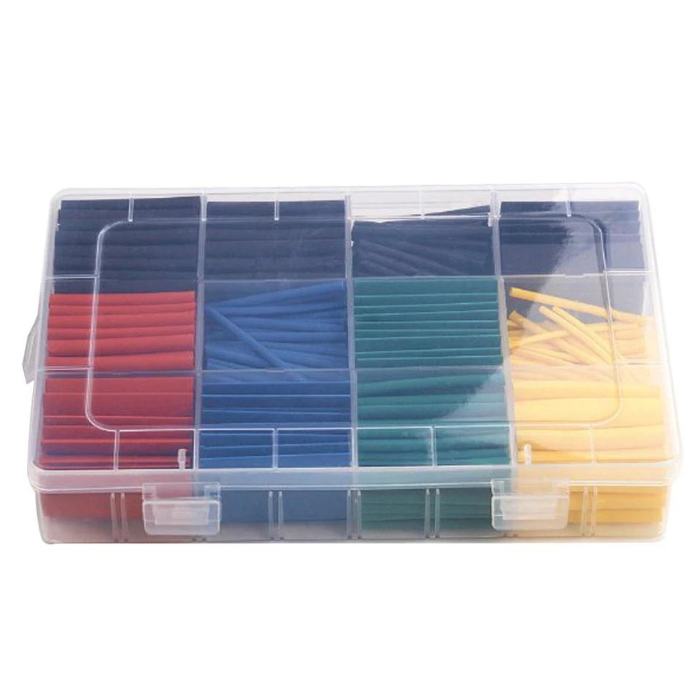Introduction
Heat shrink tubing is one of those unsung heroes in the world of wire and cable management. This humble yet incredibly versatile product has been a go-to solution for electricians, technicians, and DIY enthusiasts for decades, and for good reason.
Heat shrink tubing is a pre-expanded tube made from various insulating materials like polyolefin, PVC, FEP, or PTFE. When exposed to heat, it shrinks down to create a tight, protective seal around wires, cables, connectors, and other components. It's like a magical shrink-wrap for your wiring needs.
The beauty of heat shrink tubing lies in its simplicity and effectiveness. It offers a host of benefits that make it an indispensable tool in any electrician's toolkit:
- Insulation and Protection: Heat shrink tubing acts as a barrier against moisture, abrasion, and chemical exposure, ensuring your wires and connections remain safe and functional.
- Color-coding and Organization: With a wide range of colors available, heat shrink tubing allows you to color-code and bundle your wires, making it easier to identify and maintain complex systems.
- Extending Cable Lifespan: For outdoor applications, heat shrink tubing's weather-resistant and UV-resistant properties help protect cables and wiring from the harsh effects of sun exposure, rain, and other environmental factors, significantly increasing their lifespan.
- Easy Installation and Permanent Fit: Applying heat shrink tubing is a breeze, and once shrunk, it provides a secure, permanent fit that won't budge or come loose over time.

Applications of Heat Shrink Tubing
The versatility of heat shrink tubing means it finds application in a wide range of industries and settings. Here are some of the most common uses:
Electrical Insulation
One of the primary uses of heat shrink tubing is to insulate and protect electrical wires, cables, and connections from short-circuiting, moisture, and other environmental factors. Whether you're working on residential or commercial electrical systems, heat shrink tubing is an essential tool for ensuring safe and reliable electrical installations.
Wire and Cable Protection
In harsh or high-traffic environments, wires and cables are prone to physical damage, abrasion, cutting, and peeling. Heat shrink tubing acts as a protective barrier, shielding your wires and cables from these hazards, ensuring they remain intact and functional.
Wire Bundling and Color-coding
When dealing with complex wiring systems, organization is key. Heat shrink tubing allows you to bundle multiple wires or cables together, keeping them neat and tidy. Additionally, its diverse color options make it easy to color-code your wires, simplifying identification and maintenance tasks.
Outdoor Applications
The weather-resistant and UV-resistant properties of heat shrink tubing make it an ideal solution for protecting outdoor cables and wiring. Whether you're working on telecommunications, utility, or landscaping projects, heat shrink tubing can safeguard your cables from the damaging effects of sun exposure, rain, and other environmental factors, ensuring they remain operational for years to come.

How to Use Heat Shrink Tubing
Using heat shrink tubing is a straightforward process, but there are a few important steps to follow to ensure a successful installation.
Choosing the Right Tubing
The first step is to select the appropriate tubing material, size, and length for your application and environment. Different materials offer varying levels of resistance to heat, chemicals, and abrasion, so choose wisely. Additionally, you'll need to consider the tubing's recovered and expanded diameters, as well as the length needed to cover your wires or cables adequately.
Preparing the Tubing and Work Area
Safety should always be a top priority when working with heat shrink tubing. Ensure you have the necessary protective equipment, such as eye protection, gloves, and a well-ventilated work area. This will help prevent any potential injuries or exposure to fumes.
Applying Heat and Shrinking the Tubing
Once you've chosen the right tubing and prepared your work area, it's time to apply heat and shrink the tubing around your wires, cables, or connectors. This process typically involves using a heat gun or other heat source to evenly apply heat to the tubing, causing it to shrink and form a tight, secure fit around the components.

Tips and Tricks for Successful Installation
To achieve optimal results, there are a few best practices and techniques to keep in mind:
- Rotate the tubing during heating to ensure even shrinkage.
- Allow the tubing to cool slightly before handling to prevent deformation.
- Ensure uniform shrinkage by applying heat evenly and adjusting your technique as needed.
- Consider using heat shrink tubing accessories like wraps, connectors, or tape for added protection or to join multiple lengths of tubing.
Types of Heat Shrink Tubing Materials
Heat shrink tubing is available in a variety of materials, each with its own unique properties and applications. Here's a quick overview of some of the most common options:
Polyolefin
Polyolefin is a versatile and commonly used heat shrink tubing material known for its resistance to high temperatures and chemical contamination. It's a great all-around choice for many applications.
FEP (Fluorinated Ethylene Propylene)
FEP heat shrink tubing is ideal for applications involving chemical exposure, as it offers excellent chemical resistance. It's also easy to use due to its low shrinking temperature.
PVC (Polyvinyl Chloride)
PVC heat shrink tubing is commonly used for its smooth surface, which makes it well-suited for wire bundling and color-coding applications. It's an affordable and widely available option.
Silicone
Silicone heat shrink tubing is highly flexible and abrasion-resistant, making it a great choice for applications involving constant movement or vibration. It also performs exceptionally well in extreme temperatures, making it suitable for medical and sterilization applications.
PTFE (Polytetrafluoroethylene)
Also known as Teflon®, PTFE heat shrink tubing is resistant to chemicals and has low friction, making it ideal for applications involving constant movement or sliding contact.
Kynar® (PVDF)
Kynar® (PVDF) heat shrink tubing is highly flame-resistant and capable of withstanding harsh chemicals and fuels, making it an excellent choice for extreme environments such as those found in the oil and gas industry.
Viton®
Viton® heat shrink tubing is resistant to fuels, oils, and low temperatures, with exceptional durability and flexibility. It's often used in automotive and aerospace applications where these properties are essential.
Heat Shrink Tubing Accessories
While heat shrink tubing is a powerful tool on its own, there are also various accessories available that can enhance its functionality and make installations even easier.

Heat Shrink Wrap
Heat shrink wrap is a versatile alternative to electrical tape, providing a permanent and tight seal for repairs and connections. It can be wrapped around the desired area and then shrunk with heat for a secure fit.
Heat Shrink Connectors
Heat shrink connectors are designed to securely connect two lengths of heat shrink tubing, eliminating potential weak points or gaps in your installation. They provide a seamless and reliable transition between tubing sections.
Heat Shrink Tape
For small areas requiring repair or additional protection, heat shrink tape offers a more effective solution than traditional electrical wire. It can be wrapped around the desired area and then shrunk with heat for a snug, protective fit.
Choosing the Right Size
Selecting the correct size of heat shrink tubing is crucial for a successful installation. Here are a few key factors to consider:
Understanding Shrink Ratios
Most heat shrink tubing comes in 2:1, 3:1, or 4:1 shrink ratios, which indicate the extent of diameter reduction after heating. For example, a 4:1 shrink ratio means the tubing will shrink to approximately one-quarter of its original diameter.
Determining the Appropriate Diameter
As a general rule of thumb, you'll want to choose a heat shrink tubing size with a recovered diameter (after shrinking) that is slightly smaller than the area you want to cover. This ensures a tight, secure fit. Typically, you'll want to select a tubing with an expanded diameter that is around 25% larger than the desired coverage area.
Considering Length Shrinkage
While the focus is often on the diameter shrinkage, it's important to remember that heat shrink tubing will also shrink in length, typically by up to 10%. When covering longer wires or cables, be sure to account for this length shrinkage to ensure adequate overlap and coverage.
Conclusion
In this comprehensive guide, we've explored the world of heat shrink tubing, covering its definition, benefits, applications, installation process, material types, accessories, and size selection criteria. From electrical insulation and wire protection to bundling and outdoor applications, heat shrink tubing has proven itself to be an invaluable tool in a wide range of industries.
Heat shrink tubing's versatility, ease of use, and effectiveness make it a must-have in any electrician's or technician's toolkit. Whether you're working on residential wiring, industrial machinery, or outdoor utility projects, this humble tubing can provide the protection and organization your wires and cables need to function reliably and safely.
When selecting heat shrink tubing, be sure to consider the specific requirements of your application, such as temperature resistance, chemical exposure, and abrasion levels. Don't be afraid to experiment with different materials and accessories to find the perfect solution for your needs.
Remember, proper installation techniques and safety precautions are crucial for achieving optimal results and ensuring a safe working environment. With the right approach and attention to detail, heat shrink tubing can be a game-changer in your wire and cable management efforts. So, what are you waiting for? Embrace the power of heat shrink tubing and take your wiring projects to new heights of organization, protection, and longevity.












